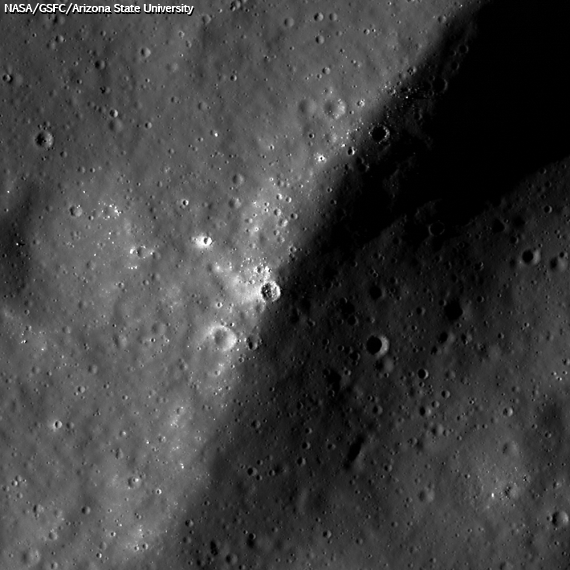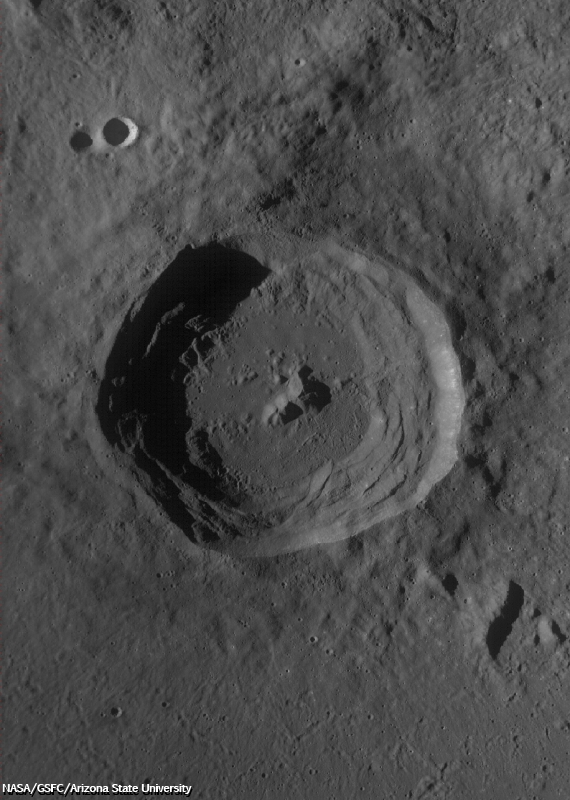
Detail of a terrace edge inside the slumped southeast inner rim of 55 km Maunder crater in Mare Orientale shown slowly being engulfed in evening shadow as the Sun sets on the Moon. LROC Narrow Angle Camera (NAC) observation M133445371RE, LRO orbit 4799, July 10, 2010; field of view 800 meters. View the full size LROC Featured Image HERE [NASA/GSFC/Arizona State University].
Drew Enns
LROC News System
Crater terraces are a common occurrence in many craters on the Moon, and along with central peaks and flat floors, terraces are a geomorphic requirement for a crater to be labeled as complex.
These forms are key to distinguishing between simple craters and complex craters. But how do these distinctive terraces form?

LROC Wide Angle Camera (WAC) observation swept up at roughly the same time as the LROC Featured Image released September 13, 2011 (area marked by yellow arrow). Resolution 71.5 meters per pixel, incidence angle 79° [NASA/GSFC/Arizona State University].

Maunder with it's slumped inner rim terraces and outer rim ejecta blanket on the north floor of Mare Orientale, from LROC WAC monochrome (643nm) mosaic swept up a little earlier in the local evening, over the course of four orbital passes, January 14, 2010. Resolution 87 meters per pixel, north is up, east-west field of view 85 km [NASA/GSFC/Arizona State University].
During the excavation stage of crater formation, complex craters experience uplift of the central portion of the crater. This results in one of the most distinctive features of complex craters, their central peaks. But while the uplift creates a central peak, it also causes collapse of the crater rim. This collapse occurs along faults that form as large blocks of rock start to slump inward, increasing the final diameter of the crater. Amazingly, most of this process is finished minutes after the impact!
Can you find more terraces in the full NAC frame?
Related Posts:
Necho's Terraces
Slumping Rim of Darwin C
Terraced Wall of Bürg Crater

False color view from high over the southwestern lunar hemisphere showing laser altimetry measurements collected by the LOLA instrument on-board LRO through March 2011. This hill-shade view brings into stark relief the multi-ring, wide-ranging effect of the Orientale impact on the Moon's west limb, straddling the Moon's near and farsides. Four km deep Maunder is the most prominent crater on the north end of the basin floor [NASA/GSFC/MSFC/LMMP].
Necho's Terraces
Slumping Rim of Darwin C
Terraced Wall of Bürg Crater

False color view from high over the southwestern lunar hemisphere showing laser altimetry measurements collected by the LOLA instrument on-board LRO through March 2011. This hill-shade view brings into stark relief the multi-ring, wide-ranging effect of the Orientale impact on the Moon's west limb, straddling the Moon's near and farsides. Four km deep Maunder is the most prominent crater on the north end of the basin floor [NASA/GSFC/MSFC/LMMP].


No comments:
Post a Comment